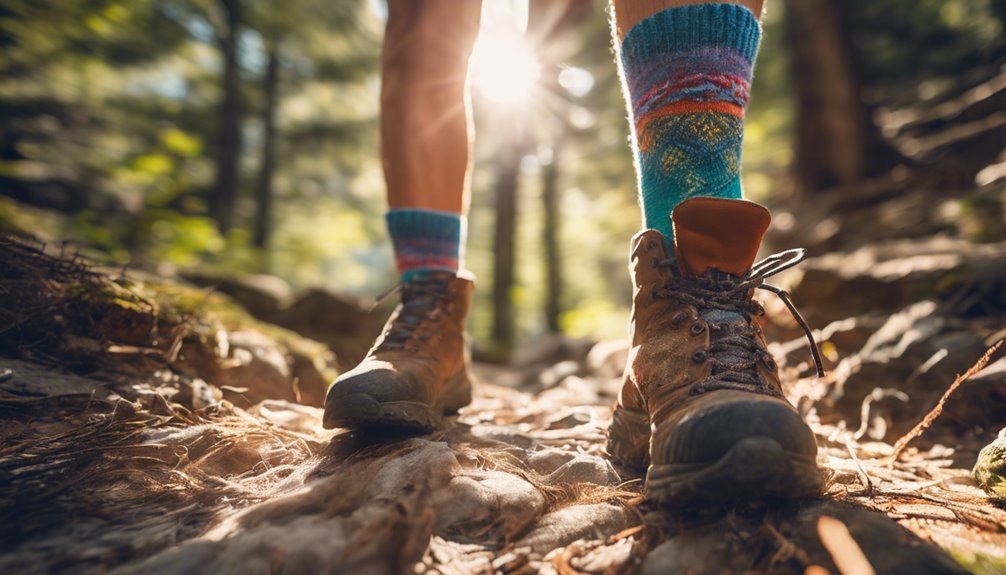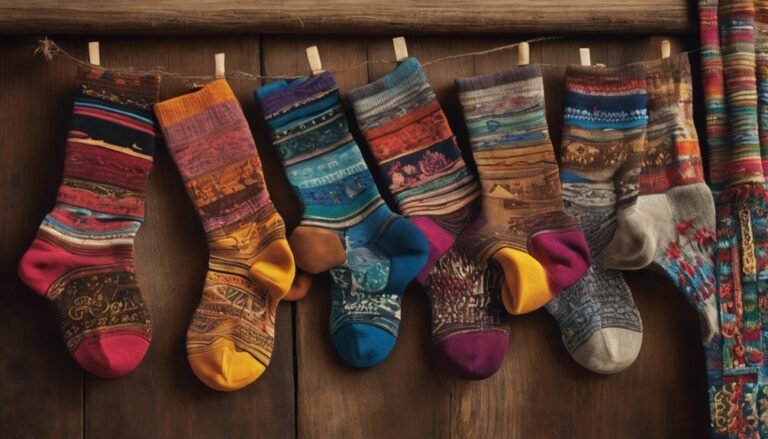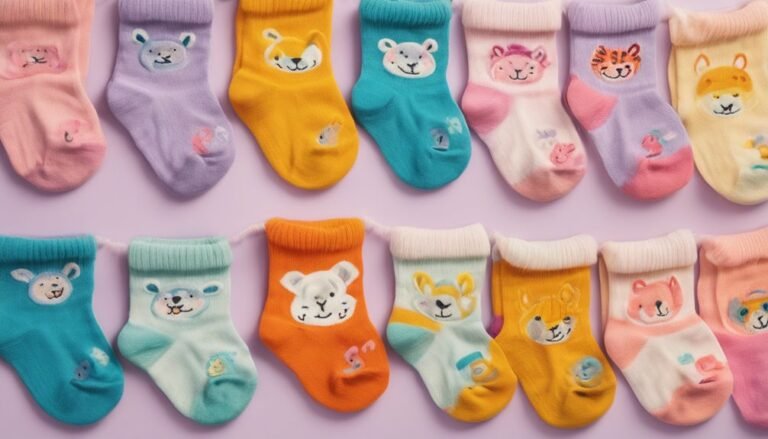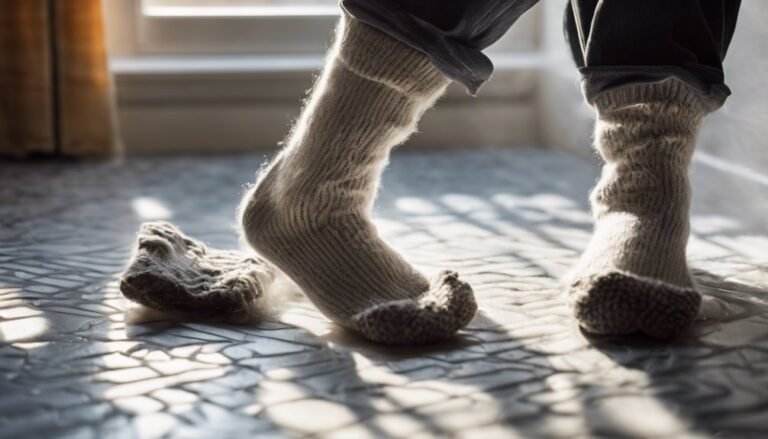Do Socks Really Prevent Blisters? Myth or Fact?
Socks do prevent blisters—it's not a myth. They act as a barrier against friction, manage moisture, and provide a snug fit, which are all essential for skin protection during physical activities. Select the right materials, like moisture-wicking synthetics, for ideal comfort. Proper sock fit reduces bunching, minimizing irritation. Additionally, you can explore various strategies, materials, and recommendations tailored to your specific activities for further insights into effective blister prevention.
Understanding Blisters: Causes and Effects

Blisters are small, fluid-filled sacs that form on the skin, typically as a response to friction, heat, or irritation. Understanding blister types, such as friction blisters, heat blisters, and blood blisters, can help you identify their causes and potential treatments. Skin sensitivity plays a significant role in blister formation; individuals with more sensitive skin may experience blisters with less friction or heat exposure than others. When engaging in activities that increase friction, like running or hiking, recognizing your skin's limitations is essential. Prevention methods, such as selecting appropriate footwear and moisture-wicking socks, can minimize irritation. Ultimately, understanding these factors empowers you to take proactive steps, reducing the risk of blister formation and enhancing your freedom to engage in physical activities without discomfort.
The Role of Friction in Blister Formation
Friction plays an essential role in blister formation by causing damage to the skin's outer layer. When your feet rub against socks or footwear, the material's properties can either exacerbate or mitigate this friction. Understanding how different sock materials interact with your skin can help you prevent blisters effectively.
Friction Causes Skin Damage
When the skin is subjected to repeated movement against a surface, it can lead to damage that manifests as blisters. This damage often stems from various friction types, undermining skin integrity. Understanding how friction contributes to blister formation is essential for anyone seeking comfort during physical activities.
Here are three key points to take into account:
- Shear Friction: This occurs when layers of skin slide against each other, leading to separation and fluid accumulation.
- Normal Friction: Direct rubbing against surfaces can wear down the outer skin layers, making them vulnerable.
- Repeated Stress: Consistent movement, like running or walking, can exacerbate friction, increasing the risk of blister development.
Sock Material Matters
Choosing the right sock material can greatly impact your comfort and the likelihood of blister formation during physical activities. The friction between your foot and sock can lead to skin damage, so selecting fabrics that minimize this friction is essential. Synthetic materials, like polyester or nylon, often offer better moisture-wicking properties, enhancing fabric breathability and reducing the risk of blisters. A breathable sock keeps your feet dry, which is important for preventing blister-causing friction. Additionally, consider sock longevity; durable materials maintain their structure and performance over time, further reducing friction risk. Investing in high-quality socks tailored for your activity can make a significant difference, allowing you to enjoy your pursuits without the discomfort of blisters.
Sock Materials: Which Ones Work Best?
When choosing socks, the material greatly influences blister prevention and comfort. Natural fibers like cotton offer breathability but may retain moisture, while synthetic fibers excel in moisture-wicking and durability. Understanding these properties can help you select the best sock for your activities and minimize the risk of blisters.
Natural Fiber Benefits
Natural fibers, like cotton, wool, and bamboo, offer distinct advantages when it comes to sock performance and foot health. These materials are known for their exceptional moisture absorption, which helps keep your feet dry and reduces the risk of blisters. Here are three benefits of choosing natural fiber socks:
- Breathability: Natural fibers allow air circulation, preventing overheating and discomfort during extended wear.
- Comfort: The softness of materials like bamboo and cotton provides a gentle touch against your skin, enhancing overall comfort.
- Odor Resistance: Wool, in particular, has natural antimicrobial properties that help combat odor, keeping your feet fresher for longer.
Opting for natural fibers can greatly contribute to your foot health and blister prevention strategy.
Synthetic Fiber Performance
While natural fibers have their benefits, synthetic fibers also play a significant role in sock performance and can be highly effective in preventing blisters. One of the primary synthetic advantages is moisture management. Materials like polyester and nylon wick sweat away, keeping your feet dry and reducing friction—the main cause of blisters. Additionally, synthetic fibers boast impressive durability, maintaining their shape and support over time, which enhances comfort during prolonged activities. The lightweight nature of these materials guarantees they won't weigh you down, allowing for greater freedom of movement. When you choose the right synthetic socks, you're not just investing in comfort; you're actively preventing the blisters that can hinder your adventures. Prioritize performance, and your feet will thank you.
The Importance of Proper Fit
Although many runners underestimate the role of sock fit in preventing blisters, wearing properly fitting socks is vital for ideal foot health. Proper sizing and fit adjustments can greatly reduce friction, a primary cause of blisters. Here are three key reasons to prioritize sock fit:
- Comfort: Socks that conform to your foot shape minimize movement and discomfort during runs.
- Stability: A snug fit guarantees the sock stays in place, reducing the chance of bunching that leads to blisters.
- Performance: Well-fitted socks enhance overall performance by allowing for better energy transfer and reduced distractions from discomfort.
Investing in the right fit can make all the difference, so don't overlook this important aspect of your running gear.
Moisture Management: How Socks Help
When you're out on a run, the last thing you want is to deal with wet, clammy feet, which can greatly increase the risk of blisters. Effective moisture control is vital for maintaining foot comfort and preventing skin irritation. Socks designed with moisture-wicking materials draw sweat away from your skin, keeping your feet dry.
| Sock Thickness | Moisture Control Effectiveness |
|---|---|
| Thin | Moderate |
| Medium | High |
| Thick | Very High |
Sock thickness also plays a role; thicker socks provide better cushioning and moisture absorption. Choosing the right combination of moisture control and sock thickness is fundamental for a blister-free experience, allowing you to focus on your run rather than your feet.
Alternative Solutions for Blister Prevention

To prevent blisters effectively, you can explore various alternative solutions beyond just choosing the right socks. While proper footwear is essential, consider these additional strategies for ideal foot care:
- Blister Treatments: Use blister prevention pads or tape to shield vulnerable areas on your feet, reducing friction.
- Moisture Management: Apply foot powders or antiperspirants to keep your feet dry, as moisture can exacerbate blister formation.
- Regular Foot Checks: Inspect your feet frequently for any signs of irritation or hotspots, allowing you to address potential issues before they escalate.
Incorporating these methods into your routine can greatly enhance your blister prevention strategy, ensuring your feet stay comfortable and blister-free during your activities.
Real-Life Experiences: What Athletes Say
Athletes often share firsthand experiences that highlight the importance of blister prevention strategies in their training and performance. Their testimonials reveal a variety of sock preferences that directly impact comfort and blister occurrence.
| Athlete Type | Sock Preference | Blister Experience |
|---|---|---|
| Marathon Runner | Moisture-wicking socks | Fewer blisters, improved performance |
| Trail Runner | Compression socks | Reduced friction, minimal blisters |
| Cyclist | Padded socks | Enhanced comfort, fewer issues |
| Triathlete | Seamless socks | No blisters, ultimate freedom |
These insights underscore the significance of choosing the right socks. It's evident that the right sock choice can enhance performance and minimize the risk of blisters, allowing athletes to focus on their goals without discomfort.
Frequently Asked Questions
Can Wearing Two Pairs of Socks Reduce Blisters?
Think of sock layering as a shield against friction. Wearing two pairs can enhance moisture management and reduce blisters, providing a barrier that minimizes skin irritation. Just remember, comfort and fit are key for effectiveness.
Do Compression Socks Prevent Blisters Effectively?
Compression socks can help prevent blisters effectively by providing compression benefits that reduce friction and enhance moisture management. This keeps your feet dry and comfortable, allowing you the freedom to move without worry during activities.
How Often Should I Change My Socks During Activities?
You should change your socks every few hours during activities, especially if they're damp. Choosing sock material with moisture management properties reduces friction and keeps your feet dry, ultimately enhancing your comfort and performance.
Are Specific Sock Brands Better for Blister Prevention?
When considering sock brands for blister prevention, focus on sock materials and cushioning technology. Brands with moisture-wicking fibers and targeted cushioning can greatly reduce friction, enhancing comfort and minimizing blister risk during your activities.
Can Blisters Form Even With Proper Sock Use?
Even with the best sock materials, blisters can still form! Friction, moisture, and movement are blister causes that might sneak in, proving that no sock is invincible. Stay vigilant and choose wisely for your feet's freedom!







